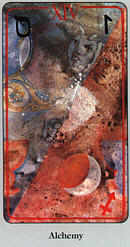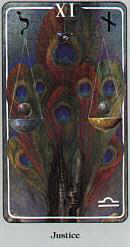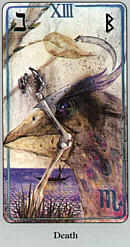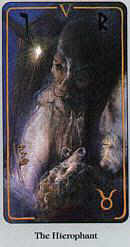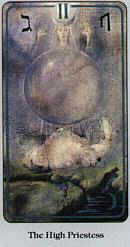Haindl Tarot Deck Review
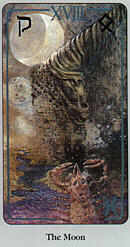
The Haindl Tarot has non-traditional imagery and is highly recommended for an advanced Tarot reader, or for meditation. The author, Hermann Haindl, was inspired by Qabbalah, Runes, I Ching, and Native American influences for the deep and compelling artwork.
Deck Type: Tarot Deck Cards: 78
Creators: Hermann Haindl
Publisher: US Games 1990
Retailers
See Price at Amazon.comSee Price at Amazon.co.uk
See Price at Amazon.ca
Haindl Tarot Review by Andryh
This enigmatic, profound and strangely beautiful deck is truly in a class by itself. The allure of the Haindl deck does not lie in a cute gimmick or theme, impressive computer graphics or pretty colors...It isn't a Rider-Waite knock-off and it isn't a Thoth knock-off (although Thoth influences are evident).
The Haindl tarot is a serious, and at times even mournful deck, which has really stepped outside the bounds of convention. But even in its sometimes startling uniqueness, the deck never deviates from being a true tarot.
The art of this deck is certainly among the best I've seen. Done in predominantly earth tones, the cards possess a dreamy and surreal quality. There are few hard lines. The depictions in the cards seem to almost melt into one another with a seamless grace. For all its somber colors, the element of light seems to radiate all the more seductively off of the bubbles, rocks and clouds that Haindl so elegantly portrays.
And symbolism? This deck is just dripping with symbols! I've owned this deck for over a year, and I'm still finding new symbols. The art is incredibly intricate and very fresh. Not to say that the traditional symbols of the tarot are void in this deck. There are many traditional symbols utilized, but Haindl has a flair for presenting them in a new light.
The cards feature figures from a wide range of myths. Egyptian, Native American, Hindu and Celtic mythology blend with surprising ease under Haindl's magical touch. The unique artistic style somehow brings a cohesiveness to this amazingly eclectic deck. The quality of this deck is utterly remarkable. The card stock is sturdy yet flexible. And even more wonderful still, the edges are perfectly (and I do mean perfectly) polished...No annoying little paper tags or tears. I love to shuffle this deck, because it simply feels wonderful. This deck is almost perfect... almost. The only "flaws" I see are in some of the pips, which are so ethereal, so vague, it is difficult to decipher a meaning from them. The fact is, that the suits (stones, wands, swords and cups) were superimposed over previously completed paintings. This is done, for the most part, to good effect. There are those few cards though, that don't readily lend themselves to their traditional interpretation. A pretty small nitpick considering what a truly awesome deck this is.
The backs bother some people.
They feature a non-symmetrical human eye that I'll
admit is somewhat unsettling...But I like it anyway. To
me, the Haindl tarot is the best money can buy. This
is not to say that everyone will like it. It is one
of those decks that either speaks to you or doesn't.
It will perhaps only appeal to a minority of tarot
readers. And yet, if it calls to you, count yourself lucky.
This deck is a treasure and a journey unto itself.
Haindl Tarot Review by Bonnie Cehovet
I came to the Haindl Tarot through a back door. I have had an interest in this deck since I first heard about it, but as fortune would have it, I ended up reading The Kabbalah Tree (by the same author/illustrator duo) first. I was so impressed by that work that I decided that it was past time to visit the deck that preceded it.
The original book that came with this deck was a very intense two volume set. Rachel wrote a second book (Haindl Tarot - A Readers Handbook), smaller and more geared to the actual reading of the cards was subsequently written, and it is that deck/book set that I am working with. I am thoroughly impressed with both the book and the deck - the work is of the intensely high quality that I have come to expect from both author and illustrator.
Some people tend to be put off by what they perceive to be the dark nature of the deck. Yes, the symbolism can be stark at times, and there is a heavy use of browns and grays, as well as muted coloring. The artwork is layered - no crisp lines, but a wonder fading in of one thing into another. The Haindl Tarot for me comes across as a very mystical, shamanic type deck. Each time you work with a card, you will see another level of richness, another "something" that you did not see or feel before. Looking back at Haindl's difficult personal history - especially the time he spent in a Russian prisoner of war camp during World War II, one can understand where the underlying seriousness comes from.
It is the shamanic quality that I see in this deck that brings across its message for me. The spiritual traditions of many cultures and mythologies are represented here. There is also a deep respect for the feminine, and a sense of respect for and connection to nature. Haindl did this deck in a very special manner - one that I have not seen done before. He took his own paintings, picking out a part of the painting that represented the energy of the card that he was working with, and overlaid the suits and symbols. The result is stunning in its depth, but it can be taken one step further. Because Haindl used only portions of a painting, he could use a single painting multiple times, with the underlying artwork acting as a bridge to connect the cards.
I am going to quote Rachel's own words in relation to the Haindl deck - she put it much better than ever could. From the book:
"This book focuses on the uses of Tarot in readings. To that end I have tried to interpret each card in more practical terms than the earlier book. Discussion of each cards symbolism and ideas focus on issues that affect peoples lives, especially emotional relationships and work, the two areas most asked about in Tarot readings. And yet, spiritual ideas so permeate Hermann Haindl's work that we cannot discuss these pictures without describing their sacred and political meanings.
Working with the "Haindl Tarot" helps us recognize that issues such as religious awareness, social responsibility, awareness of history and love of nature do not exist in separate categories, but actually fill our lives, affecting the decisions we make at work, and how we behave with our friends, lovers and family."
The Haindl Tarot makes its own path in the Tarot world. Many of the associations used are Golden Dawn in origin, but the titles on the cards show a definite Thoth influence. The card of the Fool is another step outside of the box. Haindl's Fool does not show the traditional dog, or even a less traditional cat. Haindl has used a wounded swan, tying the loss of innocence of the Fool as he takes his journey through life to the story of Parsifal, knight of the Holy Grail, who darkens his innocence by killing a swan.
In her preface to the major arcana, Rachel goes into the structure of the trumps. Of course, because this is also how I see it may have something to do with why I thought this was a great addition to the book! The major arcana is broken down into three levels, with the Fool set apart from the other cards. Level I consists of cards 1-7, and represents the basic challenges of life. Level II consists of cards 8-14, and represents our inner search for answers. Level III consists of cards 15-21, and takes us beyond personal issues into a sense of oneness with all.
The cards themselves are of good quality cardstock, and slightly oversized (2 3/4" by 5"), making it a little difficult for smaller hands to shuffle. The backs are a yellow-ochre color, and have a single, rather odd looking eye in the center. (The eye appears to have a sty in it.) Reversed cards would announce themselves with this deck. The card backs are the one thing that detracts from this deck - and might also be the one thing that would make readers back off of offering them to clients as a choice for reading decks.
The major arcana faces show a gray border, followed by a narrow black border. Approximately 1/4" in from the black border is a slightly wider colored border, representing the elemental association for each card (red for Fire, blue for Water, white for Air and yellow-ochre for Earth). At the top of the card, in white, is the card number. Across the bottom of the card, in small black letters, is the card title. In the upper left hand side we see the Hebrew letter associated with each card. In the upper right hand side we see the Rune that is associated with each card. In the lower right hand side of each card we see the astrological symbol associated with the card.
In the presentation for each of the major arcana, Rachel discuses the qualities that the card represents; the Hebrew letter and its associations; the Rune and its associations; the Astrological symbol and its associations; the Element and its associations; a description of the card; what it significance is in a reading (the upright meaning) and the reversed meaning for the card.
Normally in a review, I talk about a limited number of cards. Here I am going to let myself go and talk about what impressed me - and there was a lot that was impressive! In the background of the Fool we see a swan with a wounded breast. The Fool, dressed as a court jester, is placed in front, with his finger over the wound, as if to stop the bleeding.
The Magician has to be an all time favorite for me. In the middle of the card we see the face of Merlin. In front of him are representations of the four suits. In back of him we see a new moon, as well as a second face, which may represent Nimue, a female apprentice that Merlin taught his secrets to. The amount of layers in this card are incredible!
The Hierophant zaps you immediately into his world - and you are well aware that his is a worldapart from yours. In the middle of the card we see the face of a Grandfather, with a flowing white beard. Look closely, because the faces of a father and son also appear. This is not a card of ruler and ruled, but one of love of family. As Rachel points out, it is also a card that is specifically Jewish in thought.
The card of Strength fascinated me with its boldness. Here we see a nude woman, standing in front of a tree, with a snake wrapped around her. Her left hand is held above her head, and holds the head of the snake. Her right hand is at knee level, holding the body of the snake. This is meant to appear to be part of a ritual, and certainly portrays an enormous amount of personal energy and confidence.
I always look for the Hermit, as he is one of my birth cards. In the Haindl Tarot, the Hermit is shown facing away from us, with his lantern held upraised in his right hand. In the star at the top of the card we see the Rune Hagall, indicating that the Hermit's wisdom comes from his understanding and love of nature.
The Haindl card of Death also carries many shamanic qualities. In the forefront of the card we see the bones of an arm and hand reaching up towards the sky. Behind this we see the head of a bird, in profile, facing to the left. In the background we see blue water, with a small boat and an oarsman standing in it. What more do we need to know about the journey of releasing that which no longer serves us!
The minor arcana cards show the same border sequence, with the inner border showing the Elemental quality. The card number, suit and direction (North, South, East or West) appear at the bottom of the card in small black letters. In the upper right hand side of the Two's through Tens we see an I Ching hieroglyphic.
The presentation for the pips includes a description of the card, how the card is represented in a reading (the upright meaning) and the reversed meaning. For the Two's through Tens we also see the upright and reversed meaning for the I Ching symbol/
All four Aces literally sparkle with energy! The Ace of Wands shows a Wand with its tip sending flames up into the sky. Behind it stands a rock in the same phallic shape. The Ace of Stones (Pentacles) is one of those surreal, shamanic cards, showing a large ball in the middle of what appears to be a desert. Arched over the ball we see a rainbow, while flying over it is a black, Raven like bird. In the background we see a bright blue sky.
The court cards are titled Father, Mother, Son and Daughter. At the top of the card, in black lettering, we see the name of the person depicted on the card. Along the bottom, we see the card name, suit and direction, in black lettering. Under this, also in black lettering, we see the traditional name for the card. Haindl has chosen different cultures to represent each of the suits. Cups represent the North, and Europe; Wands represent the East, and India; Stones represent the West, and Native Americans; Swords represent the South, and Egypt.
Daughter of Stones (Pentacles) in the West is the traditional card of the Princess of Stones. In the Haindl deck, she is represented by White Buffalo Woman.
Son of Stones (Pentacles) in the West is the traditional card of the Prince of Stones. In the Haindl deck, he is represented by Chief Seattle.
Something that I always look for (generally before I read the book!) is what spreads have been included. Rachel has included several spreads in the book - my favorite being a spread called the Hagal spread. Someone else liked it - because this is the spread included in the LWB also! (OK - Rachel does say that the Hagal spread was created specifically for the Haindl deck.) There are three parts to this spread: the first four cards (from the minor arcana pips) form the middle section, and show current conditions and beliefs. The next three cards (all from the Major Arcana) form a triangle over the first four cards, and represent Spiritual History, Spiritual Task and Metamorphisis. The last three cards (taken from the court cards) form a line under the first four cards, and a Helper, Yourself and a Teacher.
Rachel also shows the following spreads, with examples: the Celtic Cross, Dream Readings and Body Readings. The spreads alone are worth the price of admission!
I would not recommend this deck to someone new to the Tarot. Nor would I necessarily recommend it as a reading deck - most clients won't want to do the work that this deck takes. I highly recommend it to those with at least a minimal Tarot background, those who want to use it for meditation, spiritual growth, ritual, ceremony or personal readings. And yes - this would be a deck that a collector would want to have!
© Bonnie Cehovet
Complete Details of Haindl Tarot
Creators: Hermann HaindlPublisher: US Games 1990
Deck Type: Tarot Deck
Cards: 78
Major Arcana: 22
Minor Arcana: 56
Deck Tradition: Mixed
Minor Arcana Style: Unique Scenes With Suit Symbols
Suits: Cups, Stones, Swords, Wands
Court Cards: Mother, Father, Daughter, Son
The Fool is 0
Strength is 8
Justice is 11
Card Size: 2.75 x 5.00 in. = 6.99cm x 12.70cm
Card Language: English
Card Back: Reversible
Rating: 16/20 or
Similar Decks to Haindl Tarot
Theme: Thoth-InspiredCategory: Available Tarot Decks
Creator: Haindl Rune Oracle by Hermann Haindl
< Previous Deck · Back to Top · Next Deck >
Home > Tarot Reviews > Haindl Tarot Review

